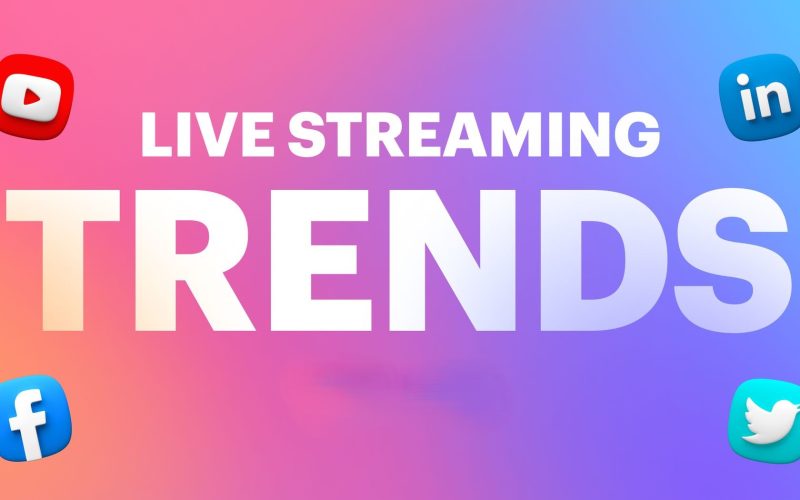Introduction
Live streaming has become one of the most popular ways for people to connect, share, and entertain in real-time. Platforms like Twitch, YouTube, and Instagram make it easy for anyone to broadcast live to an audience. As we move through 2024, it’s important to keep up with the trends that are shaping the live streaming world. In this article, we’ll discuss five key trends in live streaming that are changing how we watch and create content.
Top 5 Live Streaming Trends
1. Interactive Streaming: Connecting with Viewers

Interactive live streaming is one of the biggest trends right now. Instead of just watching, viewers can interact with the streamer by commenting, voting in polls, or asking questions. This makes the experience much more engaging.
Why It’s Important:
- Better Engagement: Viewers feel more involved in the stream when they can participate.
- Personalized Content: Creators can adjust their content based on live feedback.
- Community Building: Interactivity helps form a stronger community of fans.
Examples of Platforms:
- Twitch: Features like live chats and polls keep viewers engaged.
- YouTube: Offers live chats where users can comment during a stream.
2. Shoppable Live Streams: Shopping While Watching
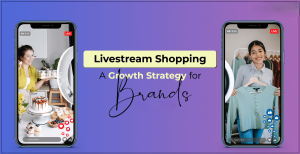
Shoppable live streaming lets viewers buy products directly during a live broadcast. Brands and influencers showcase products, and viewers can click to buy without leaving the stream. This trend is growing in industries like fashion and beauty.
Why It’s Important:
- Easy Shopping: Viewers can buy products immediately.
- Fun Shopping Experience: Watching a live demo or review makes shopping feel more exciting.
- More Sales: This approach can boost sales for brands and creators.
Examples of Platforms:
- Instagram and Facebook: Allow creators to sell products during live streams.
- TikTok: Offers live streaming features that let influencers promote products in real-time.
3. Short-Form Live Streams: Quick, On-the-Go Content

Mobile streaming has led to a rise in short live broadcasts. These are shorter, easier-to-watch streams that don’t require a big time commitment. It’s perfect for creators who want to go live quickly and for viewers who prefer brief content.
Why It’s Important:
- Convenient for Viewers: Short streams are perfect for people who don’t have a lot of time.
- Higher Engagement: People are more likely to watch a shorter stream from start to finish.
- Flexibility: Creators can go live anytime and anywhere.
Examples of Platforms:
- TikTok: Known for quick, short live streams.
- Instagram Live: Often used for short updates, Q&As, and behind-the-scenes moments.
4. Virtual and Augmented Reality (VR/AR) Streams: Next-Level Viewing

Virtual Reality (VR) and Augmented Reality (AR) are being used more in live streaming, creating immersive experiences for viewers. These technologies allow viewers to feel like they are part of the broadcast, whether it’s a concert, event, or sports game.
Why It’s Important:
- Immersive Viewing: VR and AR offer a more exciting and lifelike way to experience live streams.
- New Opportunities: Creators can host virtual events, like concerts or conferences, in virtual spaces.
- Better Engagement: Viewers get a more memorable and interactive experience.
Examples of Platforms:
- Facebook and YouTube: Experiment with VR and 360-degree live streaming.
- NextVR: Offers live sports and concerts in VR, making viewers feel like they are there in person.
5. Mobile Live Streaming: Broadcasting from Anywhere
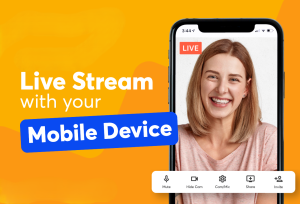
Mobile live streaming is making it easier than ever for anyone to go live from their phones. Thanks to better cameras and faster internet, mobile devices are now powerful tools for streaming. This has opened up live streaming to more people, allowing content creators to broadcast on the go.
Why It’s Important:
- Anyone Can Stream: You don’t need expensive equipment to go live – just a phone.
- On-the-Go Content: Creators can stream from any location, sharing experiences in real-time.
- Immediate Connection: Mobile live streaming lets creators connect with their audience quickly and easily.
Examples of Platforms:
- Instagram: Popular for mobile live streaming, allowing creators to share updates directly from their phones.
- YouTube: Allows users to go live from their phones, opening up opportunities for mobile-based content creation.
How Live Streaming is Changing Entertainment
Live streaming has transformed the entertainment industry. Now, people can watch concerts, sports events, and TV shows live from their homes. This means fans no longer have to miss out on events just because they can’t attend in person. Performers, musicians, and athletes can connect with their fans instantly, creating a stronger bond. Live streaming also allows viewers to interact with stars by sending messages or even making requests during the event.
Live Streaming in Education
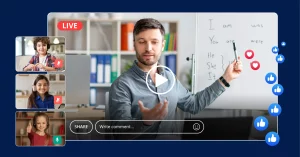
Education has also been influenced by live streaming. Teachers can now give live lessons to students from anywhere. This makes learning more flexible, as students can join classes from home. It’s especially helpful for people who can’t attend in person due to location or health reasons. Live streaming also allows for online workshops and tutorials, giving people access to new skills and knowledge they might not have had before.
Live Streaming for Business and Marketing
Businesses are using live streaming as a way to promote products, services, and connect with customers. Companies can launch new products through live streams, allowing potential customers to see them in action. This method can be more engaging than traditional advertisements. Customers can ask questions directly, and businesses can address concerns right away. This direct connection helps build trust and loyalty.
Live Streaming and Social Media

Social media platforms are playing a big role in live streaming. Sites like Instagram, Facebook, and TikTok make it easy for anyone to broadcast live to their followers. This has led to a rise in personal streaming, where influencers and everyday people can share their lives and ideas with a global audience. Social media also makes it possible for live streams to be shared and watched by more people, increasing the reach and impact of the stream.
The Growth of Mobile Live Streaming
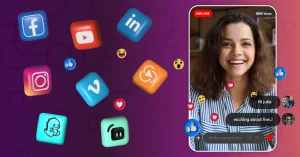
More people are using their phones to watch and stream live videos. Mobile live streaming has become very popular because it’s easy and convenient. People can go live from anywhere with just their phone and an internet connection. This is especially helpful for creators who want to stream events or experiences while they are on the go. Mobile live streaming is becoming an important way for creators to reach their audience no matter where they are.
Live Streaming for Events and Conferences

Live streaming is a great way to share events and conferences with a large audience. Many companies and organizations now broadcast their events live, so people who can’t attend in person don’t miss out. Whether it’s a business meeting, a technology conference, or a music festival, live streaming allows people from anywhere to join and experience the event in real-time. This helps companies reach a wider audience and increases the event’s impact.
The Popularity of Influencers in Live Streaming
Influencers are a big part of the live streaming world. Many influencers use live streaming to connect with their followers, show off their talents, and share their everyday lives. This gives followers the chance to interact directly with their favorite influencers through comments and live chats. Influencers often use live streaming to promote products or services, making it a powerful tool for advertising. As the influencer culture grows, live streaming is helping them reach even more people.
Live Streaming for Cooking and Food Content

Live streaming has made its way into the food industry. Many chefs and home cooks now host live cooking shows, where they share recipes and cooking tips in real-time. Viewers can ask questions, share their own experiences, and even cook along with the stream. This has made cooking more interactive and accessible to people of all skill levels. It’s a fun way to learn new recipes and cooking techniques from the comfort of home.
Live Streaming and Customer Service
Many businesses are using live streaming to improve customer service. Companies can now offer live customer support, allowing customers to ask questions and get instant help. This is especially helpful for technical problems, where a live demonstration might be needed. Live streaming allows businesses to resolve issues quickly and efficiently, improving customer satisfaction. It also helps build stronger relationships between companies and their customers.
Challenges of Live Streaming
While live streaming is exciting, it does come with some challenges. One major issue is internet connection. A slow or unreliable connection can affect the quality of the stream, making it frustrating for viewers. Additionally, content moderation is a concern, especially with large audiences. Creators need to ensure their streams remain safe and respectful for everyone involved. Managing interactions and keeping the audience engaged can also be difficult, especially when streaming for long periods.
The Future of Live Streaming

Looking ahead, live streaming will continue to grow and evolve. More advanced technologies like artificial intelligence (AI) will improve video quality and help with content moderation. Streaming will also become more interactive, allowing viewers to participate even more in real-time. As virtual events and online shopping continue to rise, we can expect live streaming to play a bigger role in how people connect, shop, and learn. The future of live streaming is full of possibilities, and it will likely keep changing in exciting ways.
Analysis of Live Streaming Trends in 2024
| Trend | Key Benefits | Platforms Leading the Trend | Audience Impact |
|---|---|---|---|
| Interactive Streaming | Better engagement, real-time feedback | Twitch, YouTube, Instagram | Creates stronger connections |
| Shoppable Live Streams | Instant purchases, immersive shopping experience | Instagram, Facebook, TikTok | Boosts sales, makes shopping fun |
| Short-Form Live Streams | Quick content, easy to watch | TikTok, Instagram, YouTube | Higher viewer retention |
| VR/AR Live Streams | Immersive experiences, exciting viewing | Facebook, YouTube, NextVR | Creates memorable viewing experiences |
| Mobile Live Streaming | Easy to access, flexible content creation | Instagram, YouTube, Facebook | Opens up live streaming for everyone |
Comparative Analysis of Live Streaming Platforms
| Feature/Platform | Twitch | YouTube | TikTok | |
|---|---|---|---|---|
| Audience Engagement | High (chat, polls) | High (comments) | Medium (chat only) | High (comments, reactions) |
| E-Commerce Integration | Medium (via third-party) | High (shoppable live) | High (shoppable live) | High (shoppable live) |
| Mobile Accessibility | Medium (app-based) | High (app-based) | High (app-based) | High (app-based) |
| Content Variety | Gaming, Music, Talk Shows | Broad (all genres) | Lifestyle, Fashion, Beauty | Short-form, entertainment |
| VR/AR Support | Low | Medium (experimental) | Low | Low |
Conclusion
Live streaming in 2024 is evolving fast, with new trends changing how creators and audiences interact. From interactive streams and shoppable broadcasts to virtual reality and mobile streaming, these trends are making live content more engaging and accessible than ever before. Whether you’re a creator or a viewer, keeping up with these trends will help you get the most out of your live streaming experience.






